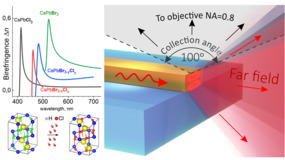The MIPT scientists jointly with their MISIS University and ITMO co-workers have found that one-of-a-kind optical properties of perovskites — being the most promising material for solar cells — are reliant upon and determined by the shape of their crystals and the conditions in which they have grown. Scientists have learned to adjust the anisotropy value by changing the chemical composition of halide perovskites. The findings may be used in building nanolasers, polarizers, waveguides and other optical devices. The work was published in Nano Letters.
Perovskites constitute flexible and lightweight semiconductor materials with quite unusual properties and structure. In terms of structure, they are similar to the natural mineral perovskite that absorbs light well and transforms it into other forms of energy owing to the way “cubes” of metal atoms and octahedrons of oxygen atoms are arranged inside of it.
Even as we speak, these power sources compare well and often outperform their silicon equivalents in terms of sunlight absorption efficiency. In addition to solar cells, perovskites may also be used to create nanolasers, LEDs and other optical devices based on unique optical properties of these materials, including their ability to interact with light in different ways depending on how light particles fall on the perovskite surface.
Scientists from the MIPT, NUST MISIS, ITMO University and the Far Eastern Federal University have obtained the first material evidence that the unique feature of perovskites — optical anisotropy — is predefined by the shape of crystals of these materials and the conditions in which they formed. The researchers arrived at this conclusion in the course of a comprehensive study of optical properties of perovskites based on the compound of lead, cesium and bromine. As noted by the researchers, it explained the contradiction of the previous studies of their colleagues, in which the anisotropy first appeared and then disappeared.
“The shape of perovskite crystals determines the degree of anisotropy. If they grew square in plane, they will not exhibit any anisotropic properties, and if they became rectangular, the perovskite will be of an anisotropic nature. It is convenient: just look at the perovskite shape, and you will get to know what optical properties it will have,” Georgy Ermolaev, a researcher at the MIPT Center for Photonics and 2D Materials, explained.
In addition, the scientists found that under certain conditions perovskites have a record high level of optical anisotropy for all known 3D materials. As summarized by the researchers, it enables to use perovskites to build highly efficient waveguides and other devices that are instrumental in controlling the light movement, which is extremely important for the creation of optical equivalents of electronics.
“We are confident that perovskites will provide a blueprint for post-silicon electronics. The NUST MISIS Laboratory of Advanced Solar Energy has implemented the process of growing CsPbBr3 single crystals and created devices based on them. We are working on new varieties of perovskite crystals for optoelectronic applications and are grateful to our ITMO and MIPT co-workers for cooperation in a challenging and interesting research project,” Artur Ishteev, Lead Engineer at the MISIS University Laboratory of Advanced Solar Energy, said.





